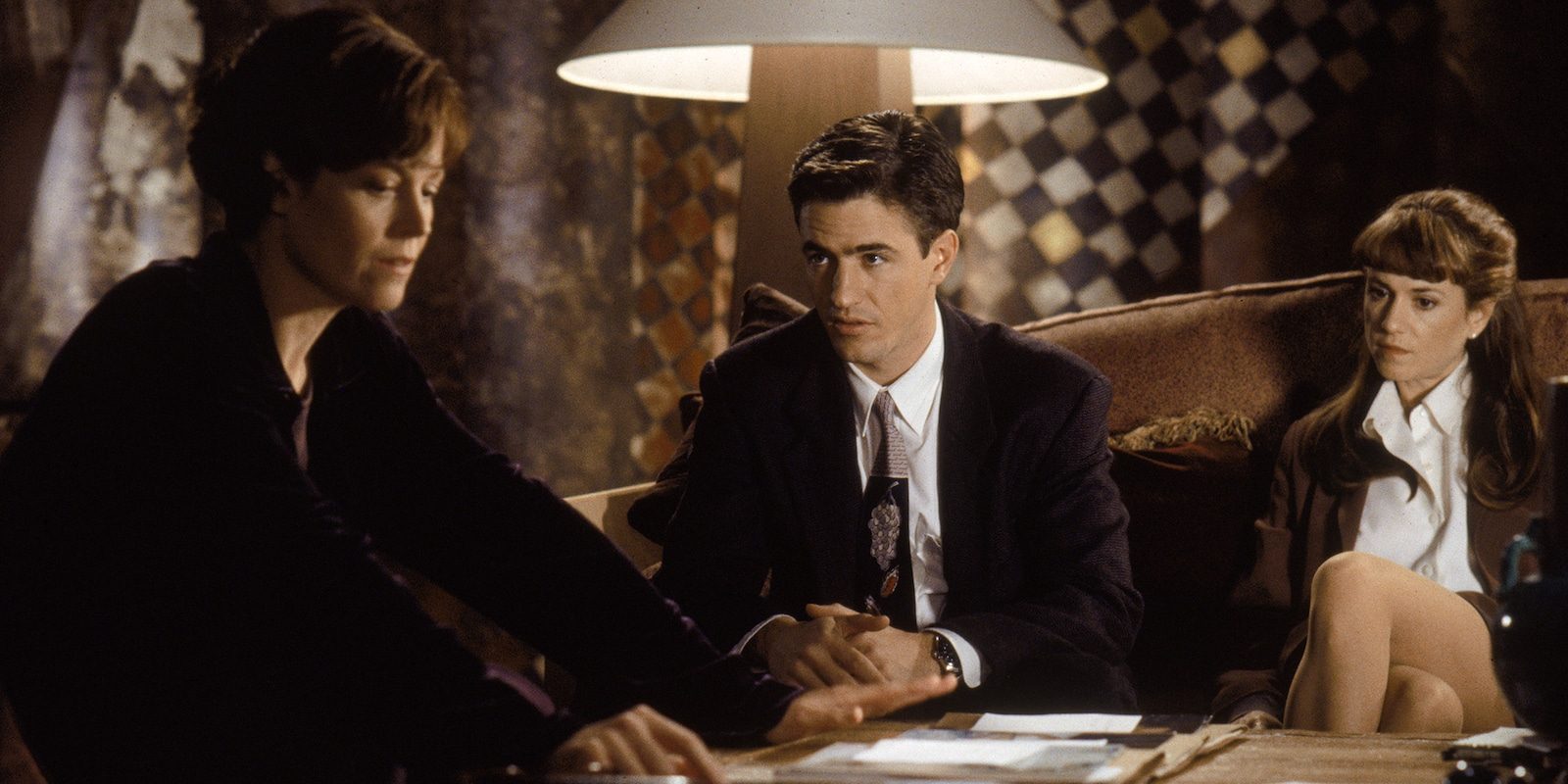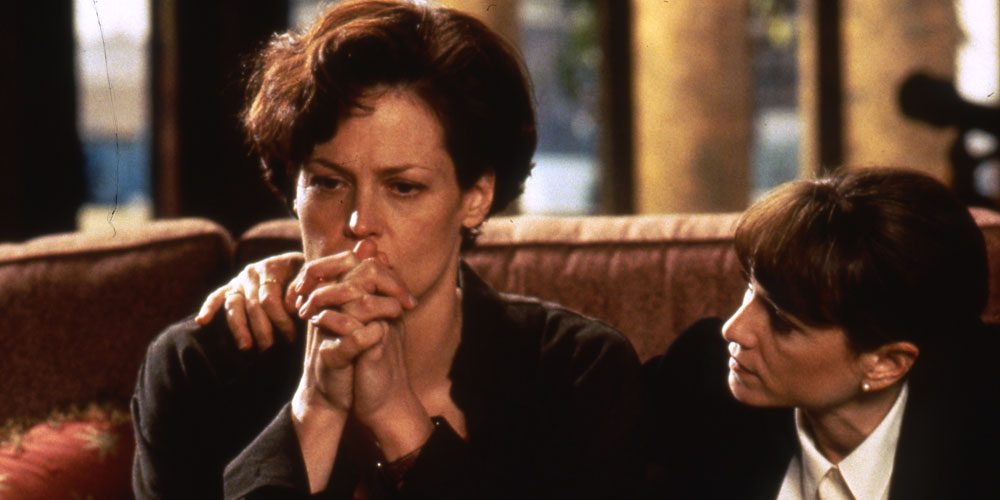Helmed by Jon Amiel, ‘Copycat’ is a 1995 serial killer film that follows two women, a psychologist and a police officer, who are dragged into the deranged plans of a serial killer in San Francisco who seems to be copying the patterns of other serial killers. Dr. Helen Hudson, a renowned psychologist, survives an attempted strangulation by a psychotic man named Daryll Lee Cullum in a university bathroom after her speech on serial killers. Thirteen months after the incident, she lives a secluded life in San Francisco.
Things take a turn when a serial killer becomes active in the city, and homicide detective Mary Jane “MJ” Monahan seeks Dr. Hudson’s help in apprehending the killer. With intense and claustrophobic frames, the film explores serial killers and their modus operandi, which are used to deliver a complex and compelling narrative. Rich with symbolism, colors, and a relentlessly tense storyline, it also explores the lasting effects of trauma, particularly on Dr. Hudson, who develops agoraphobia after her traumatic encounter. The crime thriller delves into real-life themes of criminal obsession, the psyche of serial killers, and women stuck in the schemes of violent men hellbent on destruction.
Copycat Draws Partial Inspiration From Real-Life Cases
Although ‘Copycat’ is a fictional drama, it is inspired by well-known serial killers of the past who caused terror and panic in communities when they were active. The writers Ann Biderman and David Madsen explore the intricacies of the criminal psyche by throwing light on these cases. The killer Peter Foley, who is responsible for most of the murders in the story, bases his actions on people like Albert DeSalvo (The Boston Strangler), Kenneth Bianchi and Angelo Buono Jr. (The Hillside Stranglers), David Berkowitz (The Son of Sam), Jeffrey Dahmer, and Ted Bundy. He uses the methods and patterns of these known serial killers to murder his victims, and in his own twisted way, pays tribute to them. DeSalvo was active in Boston in the early 60s and terrorized the area by killing as many as 13 women between 1962 and 1964 by sexually assaulting and then strangling them with clothing items.

Bianchi and Bruno were two cousins who remained active around Los Angeles between 1977 and 1978. They were known to leave the bodies of their victims on hills around the city. David Berkowitz is a serial killer who stabbed and shot six people between 1975 and 1977 in New York City. His victims were women who sat with their boyfriends in cars. He was also known to return to the scene of his crimes. Jeffrey Dahmer was a serial killer who brutally murdered 17 males between 1978 and 1991. He was particularly known for the sheer extent of his cruelty, including engaging in necrophilia and cannibalism. One of the most infamous serial killers in the world, Ted Bundy kidnapped, raped, and killed multiple women between 1974 and 1978. These real-life cases collectively form the nucleus of the storyline in this thriller.
Through Copycat, the Writer Wanted to Portray Serial Killers Realistically
Peter Foley, the ‘copycat’ killer, is driven to kill people by copying the methods of other known serial killers. He is brainwashed by Daryll Lee Cullum, the man who tries to kill Dr. Hudson in the beginning. Peter also assumes the identity of Peter Kurten, a German serial killer from the 1930s. Peter kills his first victim in a style akin to that of the Boston Strangler, with a body in a bathtub and strangulation by a clothing item. The next victim is an innocent girl who is found on a hill near San Francisco. The third victim is shot in a car, emulating The Son of Sam killer, followed by a heinous drugging and murder of Andy, Dr. Hudson’s assistant.

Peter tries to pay his final homage to Ted Bundy by finishing what Daryl Lee Cullum started, but Monahan stops him. In an interview to Bobbie Wygant in 1995, when asked whether he conducted a lot of research on serial killers for the film, Jon Amiel opined that he was interested in finding out who serial killers really are, he understood people like Dahmer and Ted Bundy before, but hadn’t seen them portrayed on screen very realistically. He wanted to get into the reality of the phenomenon, not seeing the killers as geniuses like Hannibal Lecter. Amiel said he wanted to get the police procedural aspect of it right.
The filmmaker wanted to scare people using this narrative. He also said that the psychology of the world of killers had to be accurate. He wasn’t interested in getting out a particular message through the film, but just entertaining the audience as best as he could. Daryll emerges as a kind of cult leader who seeks to inspire other men by telling them tales of the killers he idolizes and makes them his ‘disciples.’ The Charles Manson murders, which have been creatively dealt with by Quentin Tarantino in ‘Once Upon A Time In Hollywood’, serve as an example of charming cult leaders and their ability to turn impressionable individuals into dangerous killers.
An Investigation Into The Criminal Psyche
Profiling of criminals is an important part of police procedures. It is a process of building psychological profiles of known criminals and developing significant knowledge about other similar individuals. The Netflix show ‘Mindhunter’ explored the origin of the term “Serial Killer,” by giving deep insight into the history of the FBI and their tryst with such cases. Dr. Hudson uses similar methods to determine the actions of the killer. She is able to predict the patterns of the killings based on her experience of working on profiling serial killers from an academic viewpoint. Detective Monahan relies on these clues to take her actions. The idea of a ‘copycat’ killer delves into the darkest fascinations of dangerous men and the necessity to take innocent lives.

Peter is a victim of his own derangement and brainwashing by Daryll. The psychological aspects of the narrative are very close to real-life definitions or understandings of what makes someone a serial killer. The knowledge of FBI profiling techniques is crucial in the understanding of the criminal psyche and the various debates it leads to. Dr. Hudson, at the beginning of the film, says that 9 out of 10 serial killers are white males, which, in the context of Peter Foley, reflects a trend of male loneliness and amenity to archetypal figures like Daryll, who use the sensitivity of such individuals to achieve meaning. This is eerily close to real-life cases of people involved in serial killings or mass murder, especially in school shootings or public shootings.
To gain insights into her role, Sigourney Weaver, who plays Dr. Hudson in the film, consulted with a forensic psychiatrist named Park Dietz, who interviewed Jeffrey Dahmer. Harry Connick Jr., who plays Daryll Lee Cullum, watched documentaries on serial killers to prepare for his role. In a 1995 interview with Bobbie Wygant, Sigourney Weaver said Dr. Rene Binder helped her get the psychologist’s role right. It helped her to use the criminal profiling process in the narrative. Holly Hunter, who plays Detective Monahan, consulted an LA homicide cop called Pepper Rivera to prepare for her role, adding to the realism of her performance.
Read More: Glenn and Justin Helzer: Where Are the Killers Now?


